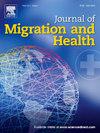印度马哈拉施特拉邦农村的临时分娩迁移和围产期保健
IF 2.9
Q1 PUBLIC, ENVIRONMENTAL & OCCUPATIONAL HEALTH
引用次数: 0
摘要
由于国家举措,印度农村的孕产妇保健得到了改善,但大多数社会人口群体仍然存在医疗保健供应不足的问题。围产期护理与临时分娩迁移(TCM)的广泛实践之间的联系仍然未被探索。临时分娩迁移是指回到自己的出生地分娩和产后。方法从Vadu健康和人口监测站(HDSS)(西马哈拉施特拉邦)2018-2022年分娩的1288名妇女样本中收集迁移和健康访问的横断面数据。分娩迁移(暴露)以三种方式进行分析:二元(任何迁移)、连续(停留时间)和多维(停留时间和提供者的变化)。结果包括健康访问的次数——设施检查和社区卫生工作者的家访——以及早期产前护理的开始。采用多元泊松回归、负二项回归和logistic回归。敏感性分析检查了回忆偏差、迁移距离的影响和模型错误说明。结果移民者和非移民者在早期产前保健启动、孕前和孕后设施访问和产前社区卫生工作者访问方面的结果相似。移民出生后社区卫生工作者就诊较少(IRR = 0.80;95% ci 0.70-0.92)。在移徙者中,出生村停留时间越长,产前访问社区卫生工作者的次数越少(IRR = 0.92;95% CI 0.88-0.96),但出生后没有(IRR = 1.03;95% ci 1.00-1.07)。在抵达出生村后就转到新提供者的妇女,基于设施的产前检查较少(IRR = 0.86;95% CI 0.78-0.96),但产后随访较多(IRR = 1.41;95% CI 1.06-1.87),无论停留多久。结论对于返回出生地分娩的妇女,住院时间和抵达后更换提供者与产妇保健接收的差异有关。有必要在围产期更多地关注流动妇女的需求,以确保她们能够在获得适当保健的同时参与关键的分娩习俗。本文章由计算机程序翻译,如有差异,请以英文原文为准。
Temporary childbirth migration and perinatal healthcare in rural Maharashtra, India
Introduction
Maternal health in rural India has improved due to national initiatives, but inadequate healthcare provision persists across most sociodemographic groups. The connection between perinatal care and the widespread practice of Temporary Childbirth Migration (TCM)—returning to one's natal home for delivery and the postpartum period—remains unexplored.
Methods
Cross-sectional data on migration and health visits were collected from a sample of 1288 women in the Vadu Health and Demographic Surveillance Site (HDSS) (Western Maharashtra) who gave birth in 2018–2022. Childbirth migration (exposure) was analyzed in three ways: binary (any migration), continuous (duration of stay), and multidimensional (duration of stay and change of provider). Outcomes included number of health visits – both facility check-ups and home visits by community health workers – and early antenatal care initiation. Multivariate poisson, negative binomial and logistic regressions were used. Sensitivity analyses checked for recall bias, the influence of migration distance, and model misspecification.
Results
Migrators and non-migrators had similar outcomes in early antenatal care initiation, facility visits (before and after pregnancy), and prenatal community health worker visits. Migrators had fewer postnatal community health worker visits (IRR = 0.80; 95 % CI 0.70–0.92). Among migrators, longer natal village stays were associated with fewer community health worker visits in the prenatal period (IRR = 0.92; 95 % CI 0.88–0.96) but not postnatally (IRR = 1.03; 95 % CI 1.00–1.07). Women who switched to a new provider upon arriving in their natal village had fewer facility-based prenatal (IRR = 0.86; 95 % CI 0.78–0.96) but more postnatal visits (IRR = 1.41; 95 % CI 1.06–1.87), regardless of how long they stayed.
Conclusion
For women who return to their natal home for childbirth, duration of stay and changing providers upon arrival are linked to differences in receipt of maternal healthcare. Increased attention to the needs of mobile women during the perinatal period is necessary to ensure they can participate in key birth customs while receiving adequate healthcare.
求助全文
通过发布文献求助,成功后即可免费获取论文全文。
去求助
来源期刊

Journal of Migration and Health
Social Sciences-Sociology and Political Science
CiteScore
5.70
自引率
8.70%
发文量
65
审稿时长
153 days
 求助内容:
求助内容: 应助结果提醒方式:
应助结果提醒方式:


